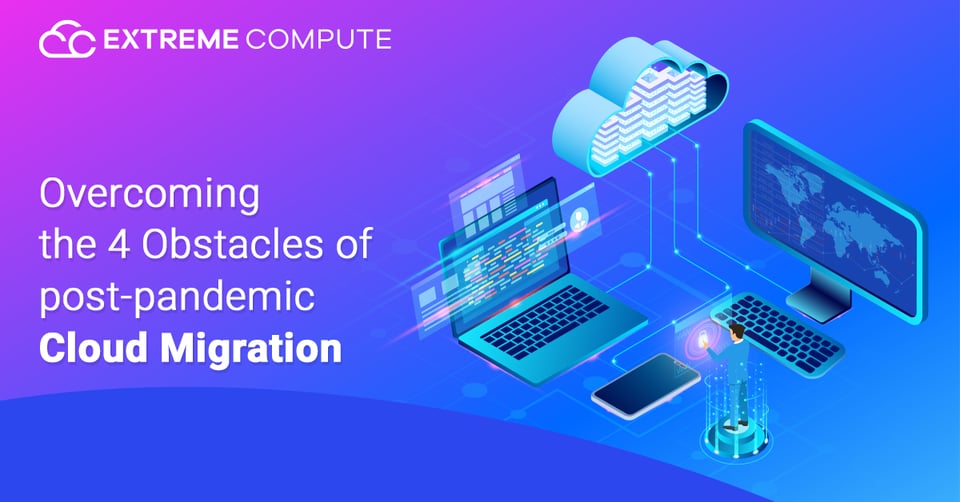Overcoming the 4 Obstacles of post-pandemic Cloud Migration

Cloud Computing, also known as Software as a Service or SaaS, allows any user to access a variety of software applications that run on shared computing devices over the internet, including disk storage, memory, and processing power. But since the pandemic transformed the way we operate more than a year ago, migrating workloads to the cloud has been a rising trend. The issue with cloud migrations is that they can be challenging and expensive, particularly when migrating applications, so the planning stage is crucial. To run on their new framework, most applications will need to be reconfigured, and you'll need to prepare ahead to ensure a smooth change. Here are four obstacles you'll face while migrating apps to the cloud and how you can overcome them.
1. Unanticipated Usage of Resources
As the project progresses, it is plausible to lose track of timelines and budget allocated for the project. Higher costs can arise as a result of rewriting applications to function properly in the cloud, as well as the people and tools required to successfully migrate your applications and performance issues. There are, however, ways to keep costs low throughout cloud migrations. Hiring a migration expert to assist you with the transfer is a good idea as these groups or individuals are familiar with the pitfalls that many businesses encounter during cloud migrations and can assist you in avoiding them.
Where possible, you can use reserved instances for your cloud environments. With reserved instances, you agree to use a certain amount of Cloud Computing power and in return, providers also provide substantial discounts. With cloud computing, you can easily scale up the number of server instances as required, ensuring that you only pay for what you use. You can also use cloud cost management software to make sure you're not paying too much for your cloud services. These applications track the cloud environments automatically and highlight places where you might save money.
2. Migrating Critical Processes
When migrating your applications to the cloud, you're probably just transferring the ones that are critical to your business processes. Moving applications is costly, so you can retire any applications that are no longer useful during your planning process. However, this ensures that these essential programs can be unavailable or less usable than the users have come to expect during the migration.
To prevent applications and their associated data from being isolated in the new environment, you must always try and move them together. Then you'll need to decide on a migration plan based on how much downtime the business can tolerate. Offline copy migration is effective if the company can tolerate a large amount of downtime, but most businesses cannot. This method involves taking offline your online application, copying all of the data, and then re-uploading it to the cloud. This could take a long time depending on how much data is in the application. This strategy is the simplest if the business can handle the downtime.
You can reduce the amount of downtime when moving your applications by using the master/read replica switch process. In your cloud environment, you build a read-only version of the application and a one-way synchronization connection from the master file to that read-only copy using this method. Any changes you make to the master file are sent to the read-only copy. This will continue until the application and data have been completely transferred to the cloud, at which point you'll switch roles, making the on-premises file the read-only version.
There is a way to prevent any downtime, but it is difficult and risky. You must maintain a master version of your application on-premises while also building a master version in your new cloud environment while migrating to master. After that, you set up two-way file synchronization. You'll eventually be able to move all of your data to the cloud version and no longer need to think about the on-premises version. Since both versions are editable, this approach may often result in distorted results.
3. Change Management
People are averse to change, particularly if they believe it will make their jobs more difficult. When you move the software to the cloud, you'll have to train your staff to use a completely different framework, which many of them would find inconvenient. Users can object to your actions at any point during the process, as well as afterward.
Make sure you have detailed training on how to use the modern cloud environment to help alleviate some of this resistance and make the change easier for users. Knowledge of how to operate the new system will help resistant users feel more confident and reduce their apprehension. Handling this change will highly boost their morale.
4. No Custom Solution
Although this could be the least looked after challenge, not adopting a complete custom solution might trigger some repercussions. While planning for migration, often businesses plan to migrate their environment and approach migration specialists halfway through the decision making process. On the contrary, processes should be thoroughly studied by experts before one decides on migration as expert opinion will result in huge cloud cost savings later.
When migration workloads, using a general solution might not work with your environment if your business has custom integrated applications that needs to be looked by a special team. Often, businesses realize halfway through the process that the plan might not be effective to certain workloads and you will need a lot of backend coding to re-orchestrate to get your systems running in a normal state. To avoid the same, you can avail expert services where many cloud vendors support you with a migration plan and help you in adopting an effective plan for your environment. Drop your queries below for tailored solutions to your needs.

